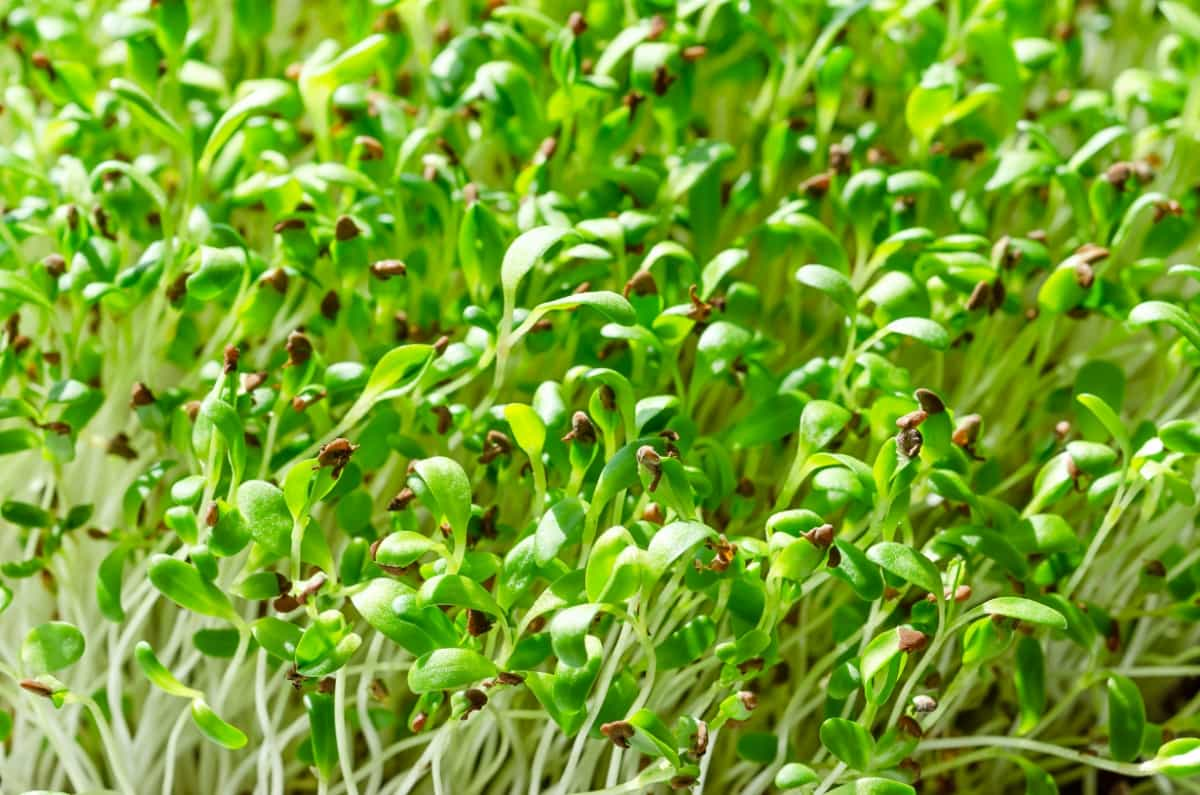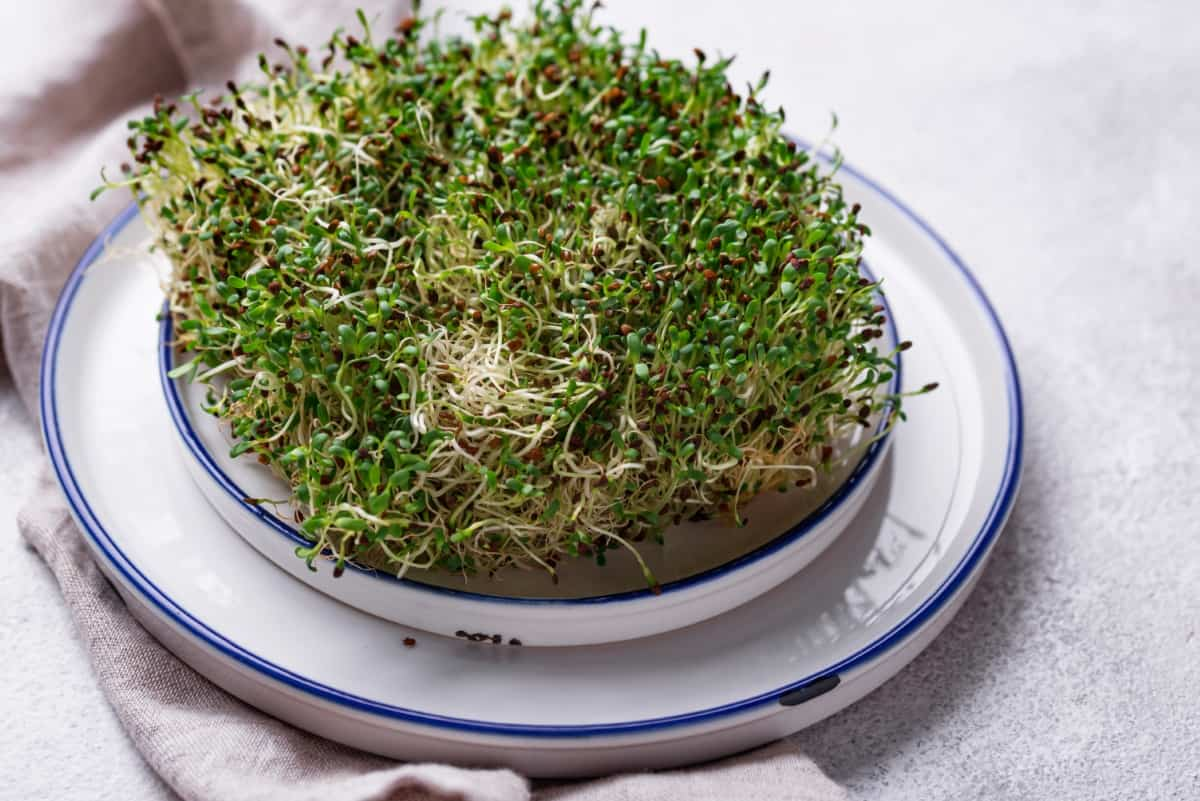Alfalfa microgreens are one of the easiest and quickest microgreens to grow. Growing your Alfalfa microgreens is both cost-effective and environmentally friendly. Growing Alfalfa microgreens is a simple and rewarding experience anyone can enjoy at home.

Guide for Growing Alfalfa Microgreens
What is Alfalfa Microgreens?
Alfalfa microgreens are one of the most popular varieties of microgreens. They are young, miniature versions of Alfalfa plants that can be easily grown indoors all year round. Growing Alfalfa microgreens is easy thanks to their quick germination time and minimal requirements for growing conditions like good drainage soil or hydroponic systems.
Materials Needed to Grow Alfalfa Microgreens
- You can choose between ceramic and plastic pots, depending on your preference.
- Purchase some high-quality soil or potting mix. The soil must be well-draining and nutrient-rich so that your sprouts can thrive.
- You will also require Alfalfa seeds, which can be easily found online or at a gardening store near you. Please make sure they’re organic and non-GMO for optimal growth.
- To water your plants effectively, grab a watering can with a long spout so that water reaches every corner of the pot without causing any damage.
- If desired, invest in grow lights as they provide additional light for plant growth during low sunlight seasons like winter.
Germination Process of Alfalfa Microgreens
- Germination is important step in growing your Alfalfa microgreens. It’s exciting because you’ll finally see those tiny seeds sprout and come to life. The germination process usually takes about 2-3 days, but it can vary depending on the temperature and humidity levels.
- During this stage, it’s important to keep your seeds moist but not soaked, as they need oxygen to grow properly. Alfalfa tends to be one of the easiest microgreens to grow.
- Once your seeds have germinated, ensure they’re placed in indirect sunlight or under artificial light if grown indoors.
Tips for Growing Alfalfa Microgreens
- Growing Alfalfa microgreens is a simple and rewarding process requiring little effort.
- Make sure the seeds are of good quality. Look for reputable sources that offer organic or non-GMO seeds. This will guarantee a higher germination rate and healthier plants.
- Provide adequate lighting for your microgreens. Alfalfa needs plenty of light to grow properly, so place them near a window.
- Avoid overwatering your plants. Alfalfa microgreens need constant moisture but not waterlogged soil. Water once or twice daily with care not to flood the pot.
- Harvest your Alfalfa microgreens at the right time to maximize their nutritional value and taste.
Steps to Grow Alfalfa Microgreens in Pots
Step 1: Choose Your Pot
- Choose a shallow container or tray with drainage holes. You can use plastic or ceramic containers, but ensure they are clean and have no cracks before planting. Alfalfa microgreens don’t require much space to grow, so a small pot around 4-6 inches wide should be enough.
- Next, think about the material of your pot. While plastic containers are common and convenient for their lightweight nature and low cost, clay or ceramic pots have better drainage properties allowing air to circulate freely through the soil.
Step 2: Prepare Your Pot
- Fill the container with high-quality, organic soil mix up to 1 inch below its rim. Flatten the surface using your fingers or a small tool gently.
- Use a high-quality soil mix that has been specifically designed for growing microgreens. The mix must be light and airy, allowing plants’ roots to grow freely. Fill the bottom of your pot with an inch or two of the potting mix. Make sure that you evenly spread it across the surface.
- After filling up some part of your container, add enough water to moisten but not saturate the soil so it’s easier to sow seeds later. Then, add another layer of soil until you reach about half an inch below the rim. Press down on the soil by using your hands to ensure its level.
In case you missed it: A Step-By-Step Guide for Growing Organic Microgreens

Step 3: Sow the Seeds
- Spread Alfalfa seeds evenly over the soil surface, covering them lightly with more soil mix. Moisten it by spraying water on top of it until moistened enough for germination. Gently press down on the Alfalfa seeds with your fingers or a tool to ensure they contact the soil. Then cover them lightly with another thin layer of soil.
- After sowing, use a misting bottle or spray bottle filled with water to moisten the surface of your newly planted Alfalfa microgreens without washing away any of the seeds.
- Place your pot in an area where it can receive plenty of natural light but is protected from extreme weather conditions.
Step 4: Water and Fertilize
- Watering is critical after sowing since dryness may cause poor germination results. Spray water on top regularly once or twice per day until harvesting time arrives. No extra fertilizer is needed as long as using quality organic soil mixed well before planting.
- Watering is especially crucial during the early stages of growth when the roots are still developing. To water your Alfalfa microgreens, use a spray bottle or watering can with a fine mist setting to avoid disturbing the delicate seeds. Be sure not to overwater the plant, which can lead to mold and rot.
Step 5: Harvesting
The best time to harvest Alfalfa microgreens is when the leaves are a few inches tall. Gently cut the stems above the soil line using sharp scissors or gardening shears. Be careful not to damage any plants while harvesting. Once harvested, rinse the microgreens thoroughly with cool water and dry with paper towels or a clean cloth.
Ideal Time to Harvest Alfalfa Microgreens
- When it comes to harvesting your Alfalfa microgreens, timing is key. You want to harvest them right for the best flavor and nutritional value. The good news is that Alfalfa microgreens are one of the quickest and easiest microgreens to grow.
- The ideal time for harvesting Alfalfa microgreens is 6-10 days after germination. They should have grown about an inch tall with a couple of leaves on each stem. If you wait too long, microgreens can become bitter or tough.
- Use scissors to cut off the stems just above the soil line to harvest your Alfalfa microgreens.
In case you missed it: Hydroponic Microgreens Farming in a Greenhouse: Key Rules to Start from Scratch

Conclusion
Alfalfa microgreens are easy to grow and require little in the way of maintenance. Water them regularly and provide a healthy soil mix, and you’ll be rewarded with a bountiful crop of delicious greens in no time.
- Feed Your Flock for Less: Top 10 Tips to Save on Chicken Feed
- Ultimate Guide to Ossabaw Island Hog: Breeding, Raising, Diet, and Care
- Hatching Answers: The Top 10 Reasons Your Chickens Aren’t Laying Eggs
- Eggs and Economics: Breaking Down the Cost of Raising Backyard Chickens
- Defend Your Greens: Proven Methods to Keep Iguanas Out of Your Garden
- Ultimate Guide to Cinnamon Queen Chicken: A Comprehensive Guide for Beginners
- Ultimate Guide to California Tan Chicken: Breeding, Raising, Diet, Egg-Production and Care
- Ultimate Guide to Marsh Daisy Chicken: Breeding, Raising, Diet, and Care
- 10 Types of Chicken Farming Businesses You Can Start for Profits